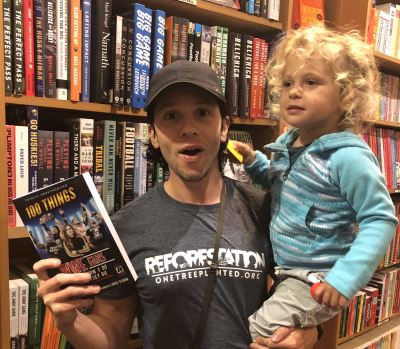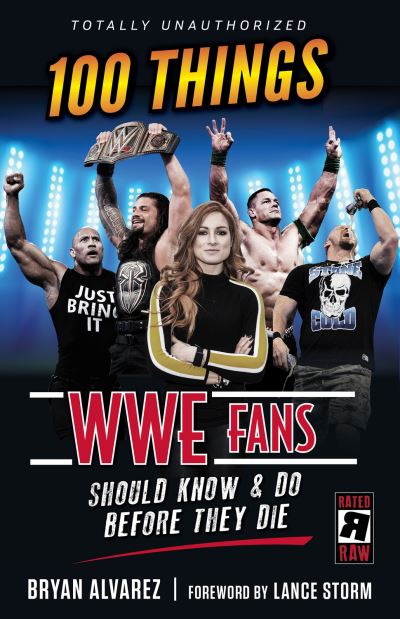
Bryan Alvarez and his daughter excitedly discover his new book in the store. Twitter photo.
Triumph Books recently released Bryan Alvarez’s 100 Things WWE Fans Should Know and Do Before They Die. The book is chock-full of information on how the WWWF grew to become the WWE that it is today, with a lot in between.
From legendary promos, to activities that WWE fans can enjoy doing such as visiting WWE Fan Axxess, to the real life build-up of characters that would come to dominate the WWE landscape, this book will leave the curious fan to the WWE diehard full of knowledge and insight. This comprehensive road-map is postmodern as it is an exhaustive collective history that Alvarez has pieced together emphasizing the turbulent, roller-coaster ups and downs that the WWE has seen over the past few decades.
Early on, Alvarez explains that the WWE has created a revisionist history that includes cover-ups to scandals and exaggerations about the wrestlers’ caricatures including the Hulk Hogan steroid scandal of the 1980s and the height of Andre the Giant. Alvarez also discusses the current WWE wellness policy and why the WWE was in desperate need of one.
Occasionally, Alvarez plugs The Wrestling Observer Newsletter, the industry bible that he runs with Dave Meltzer, but it is in a self-conscious yet polite manner. There really are not many plugs in this book, but they do exist, which include a chapter that allows Alvarez to tell his own story, which includes being a wrestler himself and publishing the Figure Four Weekly newsletter.
While it is a book about the WWE, Alvarez makes mention of other wrestling, including Japan and Mexico, especially since there have been so many five-star match ratings from Meltzer for various puroresu and lucha libre bouts in comparison to those in the WWE.
What Alvarez really highlights are not only the successes and personal victories that various professional wrestlers celebrated, but also the real life struggles and adversities that even the now billionaire, Vince McMahon had to face while starting out in the business.
And because it isn’t revisionist history, the ghostly tragedies contained within leave a lasting impression, a stain on one’s memory and heartache of the soul that are difficult to read.
SLAM! Wrestling caught up with Alvarez for an exclusive phone interview to discuss his new book. Alvarez started writing his new book in July 2018 and “pretty much worked on it on the week throughout WrestleMania for a good 7-8 months.” Writing a book isn’t an easy task, for anyone, and Alvarez admitted that even though it was his second book, after the bestselling Death of WCW co-written with R.D. Reynolds.
There are journeys of personal growth and triumph, but there are also sections of the book which contain dark and dire tragedies. Some of these sections were difficult for Alvarez. “The hardest one to write was the Chris Benoit episode. It’s a period of time that I don’t have much memory of. I didn’t even proofread it at the time. I wrote it, published it, and never wrote in it again. Having to write the letter that he wrote that was the most difficult. Wrestlers passing away are always hard but the Benoit entry was the hardest to write.”
Already having experience as a writer through Death of WCW, Alvarez was approached by Triumph Books about writing a new book about professional wrestling but the publisher also wanted a good foreword; it ended up being Lance Storm. “When we first talked about writing the book the publishing company said, ‘Do you think that anyone in WWE would write the foreword?’ Lance did podcasts on our websites and is someone who worked in the WWE, WCW and ECW and knew a lot of the people, as well as incidents in the book. He was a really smart guy. He was also very happy to do it and he was surprised that I asked him. He was the obvious choice.” Storm’s forward helps highlight the experiences of wrestling fandom that the book offers their readership as ideas to implement in their daily lives.

When asked whether the WWE employs the use of propaganda, Alvarez agreed. “Absolutely. No one tries to alter history more than the WWE. They do it under the guise of, ‘It’s just fake pro wrestling; it’s a part of the story’. It’s just a part of the story that there were 90,000 people there when there weren’t. It’s a part of the entertainment portion of the show. In Japan, it’s totally different. In the WWE they’ll move people to the other side of the building so that it looks full.” He went on to describe an event in which a friend had purchased premium seats only to be moved to a cheaper section of the arena and asserted that, “Professional wrestling is treated more as a sport in other countries. WWE wants to make it look like it’s full. Nothing illegal but fans do get mad.”
With the WWE’s use of propaganda, and the book’s format being a post-modern road which takes the reader not down a coherent, linear road of chronology, but which moves back and forth in time, like an automatic time-machine, it is easy to make the claim that 100 Things WWE Fans Should Know and Do Before They Die is a solid work of postmodernism, which Alvarez agrees with. “Oh yeah. It’s definitely postmodern. Death of WCW, same thing. A list. A book that a WWE fan can read. It’s not like a chronology but if you read this entire book but you basically have a history of WWE.” That being said, Alvarez was limited in terms of word count as each entry in the book consists of approximately 1,000 words.
It also contains a glossary, and an R Rating … Alvarez chose to include terms that are essential to a pro wrestling fan’s vocabulary, but left out terms that ‘smarks’ or ‘marks’ often use. “I hate the word move-set. No such thing as the word move-set. Never used the word. My book contains terms that are only used in wrestling and can only tell the story by using those words.”
Despite the R rating on the cover, the book is actually youth-friendly. Bryan was asked by publishing executives if he wanted to write a book that was either more for children or one better suited towards adults. The demographic of the book ended up being wide-ranging. “The R rating is a part of the design of the book,” he explained. Some sections of the book are more edgy than others which include the infamous Hulk Hogan scandals. Alvarez had to ask himself, “If I write a book for kids do I really want to talk about racial slurs and the Hogan sex tape?” He continued, “I want to write this book for everybody. Parents can decide if they want their kids to read about it. Kids can read it.”
While many of the WWE superstars in the book have been bonafide champions within the WWE, the book is heavily centered on masculine figures, without an equal share of WWE women’s stars. Alvarez noted that WWE has only recently pushed women athletes as equals within the company, and beyond that, its history is spotty at best. It does include a section on the Divas Revolution, which is important to highlight, along with sections that consist of information on Chyna and Becky Lynch, but many women are left out of the comprehensive history of the WWE, which may leave reader asking why?
Alvarez defended his choice. “The reality with the women’s they were not important parts of the show. There were a few, such as Chyna. It’s the way that the WWE pushed the women.” They are absent from the book and as they were overshadowed on the WWE program. It is the overtly sexualized and objectified male-gaze of women that Alvarez discusses in his book which plagued the WWE during The Attitude Era.
For all the WWE info, readers will come away with an appreciation for Alvarez too.
In a very memorable section of the book, he discusses his role as a youth wrestler working for a backyard wrestling promotion known as Youth Wrestling Foundation. They were children wrestling with joy, and the bleak prospects of what the future would have in hold.
Alvarez stood up on his own two feet, starting a newsletter which contained results from their shows. The ball started rolling from there. That is when his creative output spiraled to new heights. Alvarez remembers “having a positive attitude” and looks back fondly on those days. The only time he thought about quitting was after receiving a lengthy phone hot-line bill, which his grandmother handled at the time by acting like legal representation. This was the only time he ever thought about quitting. Alvarez told SLAM! Wrestling that those days were, “tough, but not that tough,” And that he “looks back upon those days fondly.”

